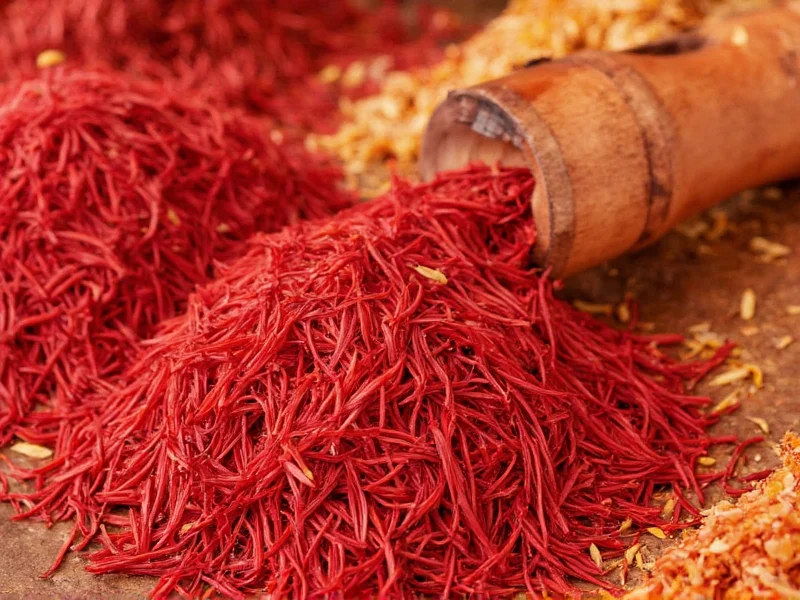As of 2024, saffron typically sells for $10-$30 per gram at retail and $500-$3,000 per pound wholesale. Premium grade (ISO Category I) saffron commands the highest prices, while lower grades (Category III) cost significantly less. Prices vary based on origin, quality, quantity purchased, and whether buying retail or wholesale.
Understanding saffron pricing requires examining multiple factors beyond a simple per-ounce cost. This precious spice remains the world's most expensive due to its labor-intensive harvesting process—it takes approximately 75,000 crocus flowers to produce just one pound of dried saffron threads. The current market reflects both traditional production methods and growing global demand.
Why Saffron Commands Premium Pricing
Saffron's extraordinary cost stems from its painstaking cultivation requirements. Each delicate Crocus sativus flower produces only three stigmas, which must be hand-picked at dawn before the flowers fully open. The harvesting window lasts merely 1-2 weeks annually, requiring massive labor forces working in precise conditions. After picking, the stigmas undergo careful drying to preserve their chemical compounds—particularly crocin (responsible for color), picrocrocin (for flavor), and safranal (for aroma).
Saffron Price Factors Explained
Several critical elements determine how much does saffron sell for in today's market:
Quality Grading System
The International Organization for Standardization (ISO) established a quality classification system based on chemical analysis. Higher crocin, picrocrocin, and safranal concentrations yield better grades and higher prices:
| ISO Category | Crocin Level | Picrocrocin Level | Safranal Level | Retail Price per Gram |
|---|---|---|---|---|
| Category I (Premium) | >190 | >80 | >20 | $20-$30 |
| Category II (Superior) | 150-190 | 60-80 | 15-20 | $15-$20 |
| Category III (Regular) | 110-150 | 40-60 | 10-15 | $10-$15 |
Geographical Origin Impact
Iran produces approximately 90% of the world's saffron, making it generally more affordable than saffron from other regions. Spanish saffron (particularly La Mancha variety) commands premium pricing due to protected designation of origin status. Kashmiri saffron, while exceptional quality, faces supply chain challenges that increase costs. Recent market data shows:
- Iranian saffron: $500-$1,500 per pound wholesale
- Spanish saffron: $1,500-$2,500 per pound wholesale
- Kashmiri saffron: $2,000-$3,000 per pound wholesale
- American-grown saffron: $2,500-$3,500 per pound wholesale
Retail vs. Wholesale Saffron Pricing
Understanding the difference between retail and wholesale saffron cost is essential when evaluating how much does saffron sell for. Retail prices include packaging, marketing, and multiple distribution layers:
- Retail (small quantities): $10-$30 per gram ($280-$850 per ounce)
- Wholesale (100g+): $15-$50 per gram ($425-$1,400 per ounce)
- Commercial bulk (1kg+): $500-$3,000 per pound
Many consumers wonder why saffron price per ounce seems astronomical compared to other spices. When converted to per-use cost, however, high-quality saffron becomes more reasonable—a single gram typically seasons 20-30 dishes.
Current Market Trends Affecting Saffron Cost
Several factors have influenced saffron pricing in recent years:
- Climate challenges: Drought conditions in Iran have reduced yields, increasing premium saffron cost
- Increased global demand: Rising popularity in Western cuisine has boosted consumption by 15% annually
- Quality awareness: Consumers increasingly seek certified pure saffron, driving up prices for verified products
- Supply chain issues: Post-pandemic logistics challenges temporarily increased saffron price per pound by 20-30%
Evaluating Fair Saffron Pricing
When determining if a saffron price seems reasonable, consider these verification methods:
- Check ISO certification: Reputable sellers provide ISO category documentation
- Examine thread appearance: Premium saffron shows deep red color with minimal yellow styles
- Perform water test: Genuine saffron gradually releases golden-yellow color in warm water
- Compare per-use cost: Calculate cost per dish rather than per ounce for realistic value assessment
- Research seller reputation: Established specialty spice merchants typically offer better value than unknown online sellers
Be wary of suspiciously low prices—authentic saffron cannot legitimately cost less than $5 per gram retail. Many bargain saffron products contain fillers like safflower or marigold, or use lower-quality saffron with excessive yellow styles.
Smart Saffron Purchasing Strategies
For consumers seeking the best value when purchasing saffron, consider these approaches:
- Purchase whole threads rather than powder to verify authenticity
- Buy from reputable specialty spice merchants with transparent sourcing
- Consider smaller quantities of higher-grade saffron rather than larger amounts of lower quality
- Store saffron properly in airtight containers away from light to maximize shelf life
- Compare prices based on actual usable quantity rather than package weight
Professional chefs often establish relationships with specialty importers to access better wholesale saffron pricing. Home cooks can join spice clubs or co-ops to access near-wholesale rates while purchasing smaller quantities.
Future Saffron Price Projections
Industry analysts predict continued upward pressure on saffron pricing due to:
- Increasing labor costs in primary growing regions
- Climate change impacts on traditional cultivation areas
- Expanding global demand from emerging markets
- Greater consumer awareness of quality differences
However, new cultivation efforts in countries like Greece, Morocco, and the United States may help moderate price increases through diversified supply chains. The development of more efficient harvesting techniques could also impact future saffron cost trends.
Understanding Saffron Value Beyond Price
When evaluating how much does saffron sell for, remember that this spice offers unique properties unmatched by alternatives. Its complex flavor profile, vibrant coloring ability, and potential health benefits contribute to its enduring value. Unlike many spices that lose potency quickly, properly stored saffron maintains its quality for 2-3 years, making the per-use cost more reasonable than initial pricing suggests.











 浙公网安备
33010002000092号
浙公网安备
33010002000092号 浙B2-20120091-4
浙B2-20120091-4